As the day dawns on a film set, every crew member’s heartbeat syncs to the rhythm of one crucial document: the call sheet. It is the conductor of the symphony that is filmmaking, orchestrating each individual’s role, and maintaining harmony among the myriad moving parts.
This comprehensive guide will illuminate every aspect of the call sheet, breaking down its sections and providing a useful template to streamline your filmmaking process. Whether you’re a seasoned director or a fledgling production assistant, this article aims to enrich your understanding of the call sheet’s pivotal role in creating cinematic magic.
Table of Contents
What is a call sheet?

A call sheet is a critical document in the film industry that provides a detailed schedule for a day of production. Typically generated by the assistant director, it lays out the shooting timeline, location details, required cast and crew members, special instructions, and more.
This indispensable tool keeps everyone aligned and informed about the day’s proceedings, acting as a roadmap that ensures smooth operations and coordination on set. It allows cast and crew to understand their call times, scene descriptions, and other essential details to prepare for a day of filming. Essentially, a call sheet is the heartbeat of a film shoot, setting the pace for each day’s work.
Call Sheet Templates
Call Sheet Templates are integral tools in the film and television production industry. These preformatted documents are designed to disseminate the daily shooting schedule, scene details, and logistical information to the cast and crew.
Typically, at the top of these templates, there’s a header area. This includes the production title, the date of the shoot, and the call sheet number. This offers quick reference information.
Following this, many templates feature a general call time section. Here, the start and end times of the production day are stated. This offers a broad view of the day’s schedule.
After this, most templates have a scenes to be shot section. This includes details like scene numbers, descriptions, and estimated time for shooting each scene. This helps everyone understand the day’s shooting plan.
Why is a Call Sheet Important?
A call sheet is an essential lifeline of a film shoot, providing a detailed roadmap for the day’s operations. Here’s a breakdown of why it holds such pivotal importance in the film industry:
- Clear Communication: The call sheet is the prime method of communication between the production management team and the cast, crew, and vendors. It presents a clear picture of what’s expected on a given day, ensuring everyone is on the same page.
- Efficiency and Organization: Without a call sheet, the set can descend into chaos with individuals unsure about when they’re needed or what they’re supposed to be doing. The call sheet outlines the day’s schedule, shot order, scene details, and other important tasks. This organization fosters efficiency on set, saving time and money.
- Preparedness: The call sheet includes specific call times for each individual, ensuring everyone knows when they should arrive on set. This allows cast and crew to prepare in advance and show up ready to contribute.
- Resource Allocation: It’s a tool to help allocate resources effectively. Knowing who and what is needed for a particular scene or at a certain time allows for smart resource planning. It can prevent unnecessary overtime, equipment rental costs, or other expenses.
- Risk Management: The call sheet includes key health and safety information such as the nearest hospitals, safety protocols, and the designated first aid personnel. This information is critical for managing any potential risks on set.
- Record Keeping: From a legal and record-keeping standpoint, the call sheet is a formal record of a day’s plan on a film production. This can be crucial in the event of disputes, legal cases, or for historical reference.
- Coordination: The call sheet includes location details, weather updates, and transport arrangements, aiding in smooth coordination.
- Professionalism: Distributing a well-organized and clear call sheet signals professionalism. It sets the tone for the production and conveys the production management’s competence, increasing the confidence of all parties involved.
Key Components of a Call Sheet
A call sheet is composed of various sections, each detailing different aspects of the day’s shoot. Here are the key components and what they mean:
Header
The header contains general information about the production. This includes the project title, the director and producer’s names, the production company’s name and contact details, and the date of shooting. The header also often contains the day’s weather forecast and sunrise/sunset times, which can affect the scheduling of certain scenes.
Call Time
This is the time when each person is expected to report on set. It’s often broken down into ‘General Crew Call’ (when the majority of crew members need to arrive) and individual call times for specific actors, makeup artists, or others whose timing may differ from the rest.
Schedule
The schedule includes a detailed rundown of the day’s scenes, listed in the order they’ll be shot. It includes scene numbers, descriptions, locations, cast involved, and estimated time for each scene. It can also contain details like meal times and breaks.
Cast List
The cast list includes the names of all actors involved in that day’s shoot, their character names, and call times. It will also often detail the actors’ pick-up times for transportation and when they are needed in makeup or wardrobe.
Crew List
Similar to the cast list, this includes the names, roles, and call times for each crew member. It also provides contact details for department heads, making it easy to get in touch if needed.
Scenes
This section lists all the scenes to be shot that day, along with their descriptions, required cast members, and specific shooting requirements. This helps everyone visualize the day’s work and prepare accordingly.
Locations
Here, you’ll find details about the shooting locations, including their addresses, directions, and parking information. If multiple locations are involved, they will be listed in the order of use.
Advance Schedule
This section provides a preview of what to expect for the next day’s shoot, giving everyone a heads-up about any changes in location, call times, or scene schedules.
Special Instructions
Any specific instructions for the day, such as wardrobe changes, special effects, or important reminders, will be listed in this section.
Contacts & Emergency Info
This section includes contact details for the production office, key production staff, and emergency services, along with the addresses of nearby hospitals. This ensures help is easily reachable in case of any mishap.
Weather and Notes
The day’s expected weather conditions are included, which is crucial for planning outdoor scenes. Other notes could cover local amenities, like restaurants or coffee shops.
Craft Services/Menus
This section outlines what meals or snacks will be provided on set and the timing for meal breaks.
Parking & Transportation
If the production provides transportation or has specific parking arrangements, this section will include the relevant details.
Advance Schedules
This section gives a preview of the next few days of production. This can be very useful for cast and crew to plan their schedules ahead of time.
Commonly Used Call Sheet Abbreviations
Film sets often use abbreviations to save space and simplify communication. Here are some commonly used abbreviations you’ll encounter on a call sheet:
- AD: Assistant Director. They’re often responsible for the creation and distribution of the call sheet.
- BG: Background. This term refers to background actors or extras who appear in a scene.
- C/CH: Cast/Cast Hold. These refer to the main cast or actors, and a ‘cast hold’ means that the actor should be on standby for the day.
- D/N: Day/Night. This indicates whether the scenes will be shot during the day or night.
- E/E: Estimated or Expected End. This is the anticipated wrap-up time for the day’s shooting.
- EXT/INT: Exterior/Interior. These terms are used to describe the shooting location of a scene.
- H/MU/W: Hair/Makeup/Wardrobe. These departments are responsible for the actors’ appearance during shooting.
- I/E: In/Out. This refers to the time an individual is expected to start and finish their workday.
- SFX: Special Effects. This is used when a scene requires special effects work.
- SPFX: Special Practical Effects. This term is used when a scene requires practical, real-world effects like rain, fog, fire, etc.
- SW: Start Work. This indicates when an individual is expected to start their work.
- ND: Non-Disclosure. It means that the information should not be shared and is confidential.
- SOT: Start of Turnaround. This is the time when an actor or crew member finishes for the day, and it’s used to calculate when they can legally start work again the next day to allow for adequate rest.
- TBD: To Be Determined. When details are not yet finalized, this abbreviation is used.
- VFX: Visual Effects. This is used when a scene requires post-production visual effects.
How to Create a Call Sheet
Creating a call sheet is a vital part of the pre-production process. Here is a detailed, step-by-step guide on how to craft an effective call sheet:
Step 1: Gather Your Information
Start by compiling all the necessary details for the day’s shoot. This includes the scenes to be shot, the cast and crew involved, location details, necessary props and costumes, and any special instructions. Cross-reference with the script, shot list, and schedule to ensure nothing is missed. If you have a 1st Assistant Director (AD), they will usually be responsible for this step.
Step 2: Choose a Template or Software
Decide whether you’ll be creating your call sheet manually or using software. There are templates available online that can be edited to suit your production, or software options that can help automate the process and allow for easy updates and distribution.
Step 3: Fill Out the Header
Start with the basics: your film’s title, the production company’s name, and the contact details for the director, producer, and production office. Also include the shooting date and the day of your shooting schedule this call sheet refers to (e.g., “Day 1 of 30”).
Step 4: Input General Call Time
The general call time is when most of your crew needs to arrive on set. Note that individual departments or people might have different call times based on their roles.
Step 5: Detail the Day’s Schedule
Break down the day’s shooting schedule scene by scene. Include scene numbers, short descriptions, and the cast involved. Be sure to provide estimated timings for each scene.
Step 6: Add Cast and Crew Lists
Add a list of all cast members involved in the day’s shoot with their character names and individual call times. Do the same for the crew, listing their roles and when they should arrive.
Step 7: Provide Location Details
Include the address and any necessary directions or parking instructions for your shooting location(s). It’s also helpful to include any notes about site restrictions.
Step 8: Incorporate Contact and Emergency Info
Provide contact details for key crew members and production office. Include nearby hospitals, emergency services, and any on-set safety personnel contacts.
Step 9: Include Special Instructions
If there are any special instructions for the day (such as warnings about stunts, special effects, or difficult weather conditions), include them in this section.
Step 10: Plan for Meals
Specify when and where meals will be provided. Remember, a well-fed crew is a happy crew!
Step 11: Include Advance Schedules
If possible, give your cast and crew a heads up about the next day’s call times and location(s).
Step 12: Review and Proofread
Before sending out the call sheet, take time to review it for errors, omissions, or unclear instructions. It might be helpful to have a second pair of eyes on it.
Step 13: Distribute the Call Sheet
Once you’re satisfied with the call sheet, distribute it to everyone involved in the next day’s shoot. This is typically done via email, but some may prefer printed copies. Make sure everyone confirms receipt.
How to Read a Call Sheet
Understanding how to read a call sheet is crucial for every member involved in a film production. Here’s a step-by-step guide to help you make sense of it:
Step 1: Review the Header
Start at the top of the call sheet where you’ll find general production information. Look for the title of the production, the director, the producer, and the shooting date. You’ll also find the overall call time, which is when the majority of the crew needs to be on set.
Step 2: Check Your Call Time
Find your name on the call sheet. If you’re a crew member, you’ll likely be under the crew list. If you’re an actor, you’ll be in the cast list. Next to your name, you’ll find your individual call time. This is the time you’re expected to be ready and on set.
Step 3: Look at the Day’s Schedule
Check out the list of scenes to be shot that day. The scenes will be listed with scene numbers and brief descriptions, along with the characters involved. This section will give you a sense of the day’s workflow.
Step 4: Understand the Location Information
Find the location details. This will tell you where the shoot is happening. There should be an address and possibly additional directions or parking instructions. If there are multiple locations, they’ll be listed in the order they’ll be used.
Step 5: Check Out Special Instructions
Look for any special instructions. This could include notes about stunts, safety precautions, special effects, or weather contingencies.
Step 6: Review Contact and Emergency Info
Find the section with contact information. This will include contact details for key crew members and production office. Emergency info will include nearby hospitals, emergency services, and any on-set safety personnel contacts.
Step 7: Note the Meal Schedule
Find the meal times. It’s crucial to know when your breaks are scheduled, particularly when lunch will be. Keep in mind the “six-hour rule” in the film industry: crew must be fed within six hours from their call time.
Step 8: Take Note of Future Schedules
Check the advance schedule if available. This will give you a heads-up on the next day’s call time and location, allowing you to plan ahead.
Step 9: Look for Other Relevant Information
Finally, review any remaining information. This could include the weather forecast, special wardrobe notes, or other details specific to your role or department.
Tips for using your call sheet
Effectively using a call sheet can greatly enhance your efficiency and preparedness on set. Here are some tips on how to use your call sheet:
Read It Thoroughly
The first step in effectively using your call sheet is to read it thoroughly. Make sure you understand every aspect of it, from your individual call time to the scenes scheduled for the day.
Confirm Receipt
As soon as you receive your call sheet, confirm that you’ve got it. This lets the production team know that you are aware of your call time and the upcoming schedule.
Keep It Accessible
Always keep your call sheet handy. Having it easily accessible on your phone or a printed copy can be helpful in quickly checking details.
Plan Your Day
Use your call sheet to plan your day. Know when you need to leave home to get to set on time, consider traffic and travel time. Also, look at the schedule to see when you might have downtime.
Know Your Scenes
If you’re an actor, familiarize yourself with the scenes listed on the call sheet for the day. This will help you prepare and ensure you’re ready to perform when it’s time.
Check the Weather
Call sheets often include a weather forecast. Use this to dress appropriately and be prepared for any potential weather-related issues.
Prepare for Your Needs
Look at the meal and break times. If you have specific dietary needs or need to take regular breaks for any reason, knowing these times can be extremely useful.
Note the Next Day’s Details
If your call sheet includes an advance schedule, use it to prepare for the following day. This can help you plan your rest and manage your time effectively.
Review Emergency and Contact Info
Familiarize yourself with the emergency information and key contact numbers. You never know when you might need them.
Respect the Details
Always follow the details and instructions on the call sheet. It’s there to help coordinate potentially hundreds of people, so it’s vital for everyone to adhere to the given information.
FAQs
Who prepares the call sheet?
The production office, usually under the supervision of the assistant director (AD) team, prepares the call sheet. The first assistant director (1st AD) is typically responsible for gathering the necessary information and creating the call sheet.
When is a call sheet distributed?
Call sheets are usually distributed to the cast and crew the evening before the filming day, allowing them to review the details and plan accordingly. However, in some cases, call sheets may be distributed earlier, especially if there are changes or updates.
What should I do if I have questions or conflicts regarding the call sheet?
If you have any questions or conflicts related to the call sheet, it is advisable to contact the production office or the assistant director (AD) team. They can provide clarification, address concerns, and assist in resolving any scheduling conflicts you may have.
Can call sheets change?
Yes, call sheets can change due to various factors such as weather conditions, script revisions, technical issues, or scheduling conflicts. If there are any changes, the production office will typically issue an updated call sheet to inform the cast and crew of the modifications.
How are call sheets delivered?
Call sheets can be distributed via email, physical copies handed out on set, or through specialized production management software or applications.
What is the difference between a “shooting schedule” and a “call sheet”?
A shooting schedule is a broader document that outlines the entire production timeline, including the sequence of scenes to be filmed, locations, and estimated durations. A call sheet, on the other hand, is a specific document for a particular day of filming, providing detailed information such as call times, scene descriptions, and logistics for that specific day.
Is it mandatory to bring the call sheet to set?
It is highly recommended to bring a copy of the call sheet to set. It serves as a reference and ensures that you have all the necessary information readily available, including call times, scene details, and contact numbers. It helps you stay organized and informed throughout the filming day.
What is the difference between a “shooting schedule” and a “call sheet”?
A shooting schedule is a broader document that outlines the entire production timeline, including the sequence of scenes to be filmed, locations, and estimated durations. A call sheet, on the other hand, is a specific document for a particular day of filming, providing detailed information such as call times, scene descriptions, and logistics for that specific day.
Can I make changes to the call sheet?
As an individual cast or crew member, you generally cannot make changes to the call sheet directly. Any changes or updates should be communicated to the production office or the assistant director (AD) team. They have the authority to make modifications and issue revised call sheets if necessary.
What does “background talent” or “extras” mean on a call sheet?
“Background talent” or “extras” refers to individuals who are hired to populate a scene without having speaking roles. They are typically present to create a realistic environment or atmosphere. The call sheet may include specific instructions for background talent, such as wardrobe requirements or any specific actions they need to perform.
Is it mandatory to bring the call sheet to set?
It is highly recommended to bring a copy of the call sheet to set. It serves as a reference and ensures that you have all the necessary information readily available, including call times, scene details, and contact numbers. It helps you stay organized and informed throughout the filming day.
What is the significance of the “wrap time” on the call sheet?
The “wrap time” indicates the expected end time for the day’s filming activities. It informs the cast and crew when they are likely to finish their work for the day. However, it’s important to note that the wrap time is an estimate and can vary depending on the progress of the shoot and other factors.
Are call sheets used for pre-production and post-production as well?
Call sheets are primarily associated with the production phase of a film or TV show. However, modified versions of call sheets or similar documents may be used during pre-production or post-production stages to communicate important information, schedules, or requirements to the relevant individuals involved in those phases.
Can call sheets be accessed digitally?
Yes, call sheets can be distributed and accessed digitally through various production management software, applications, or online platforms. This allows for easier dissemination, updates, and access to the call sheet on electronic devices such as smartphones or tablets.
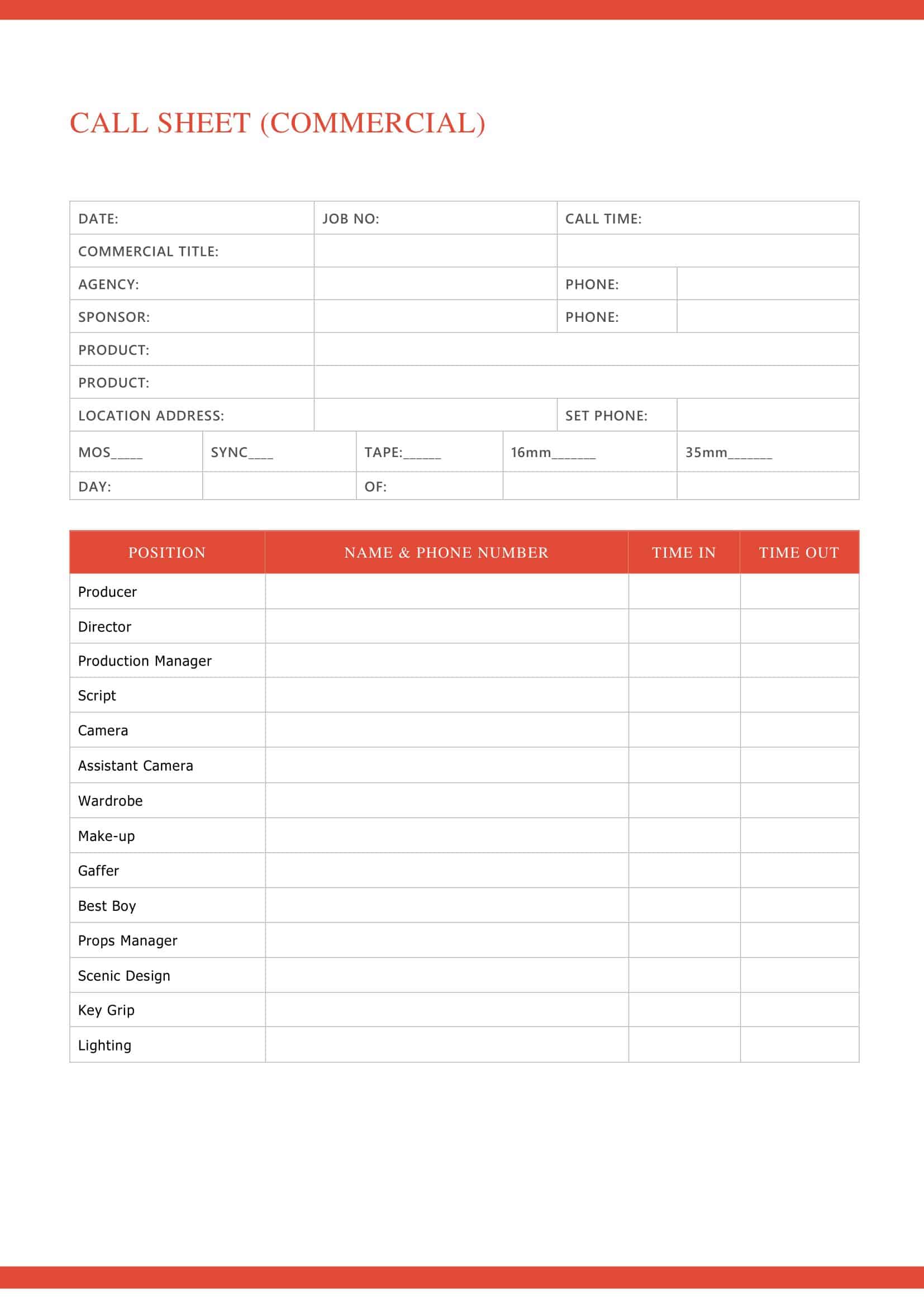











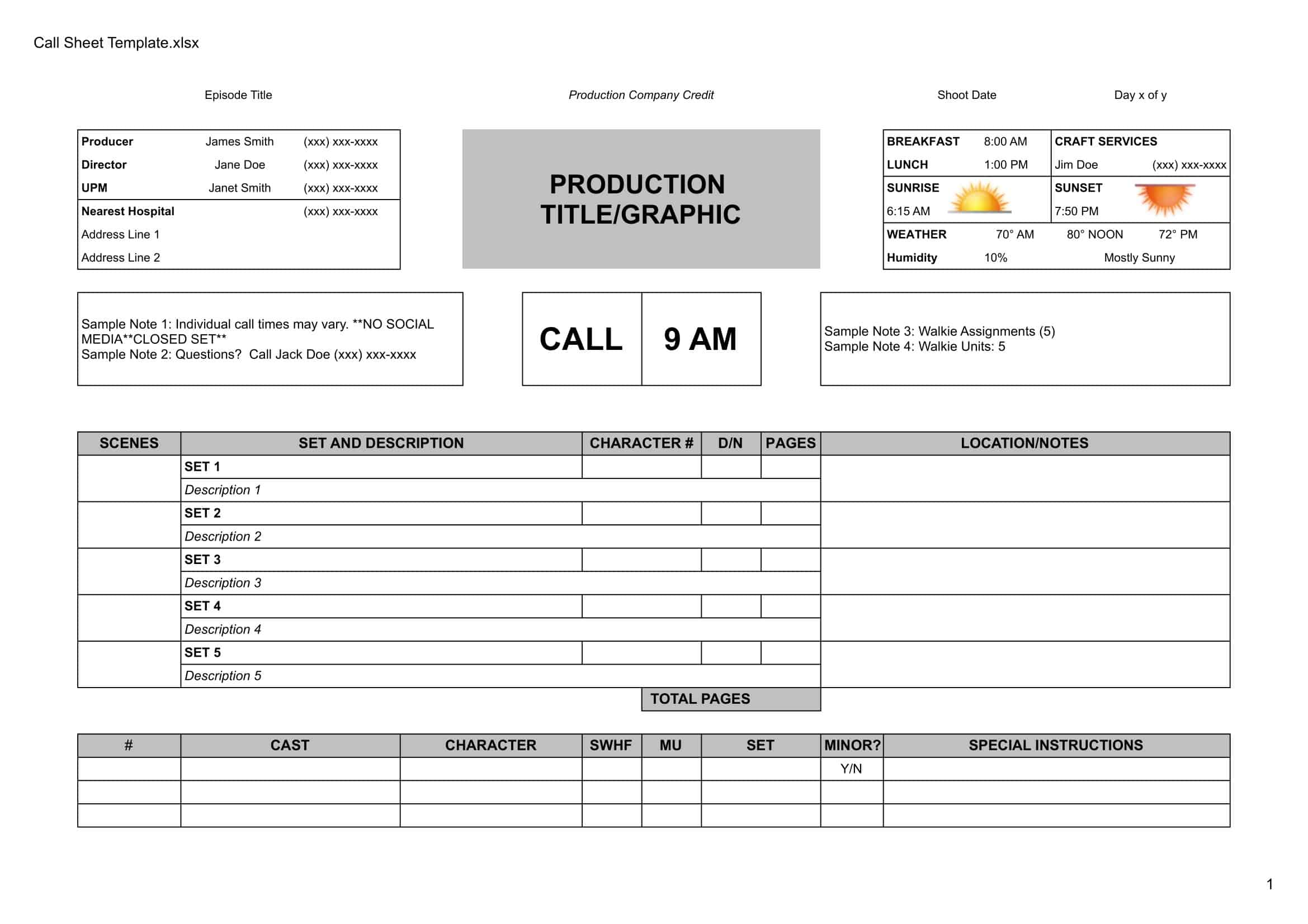



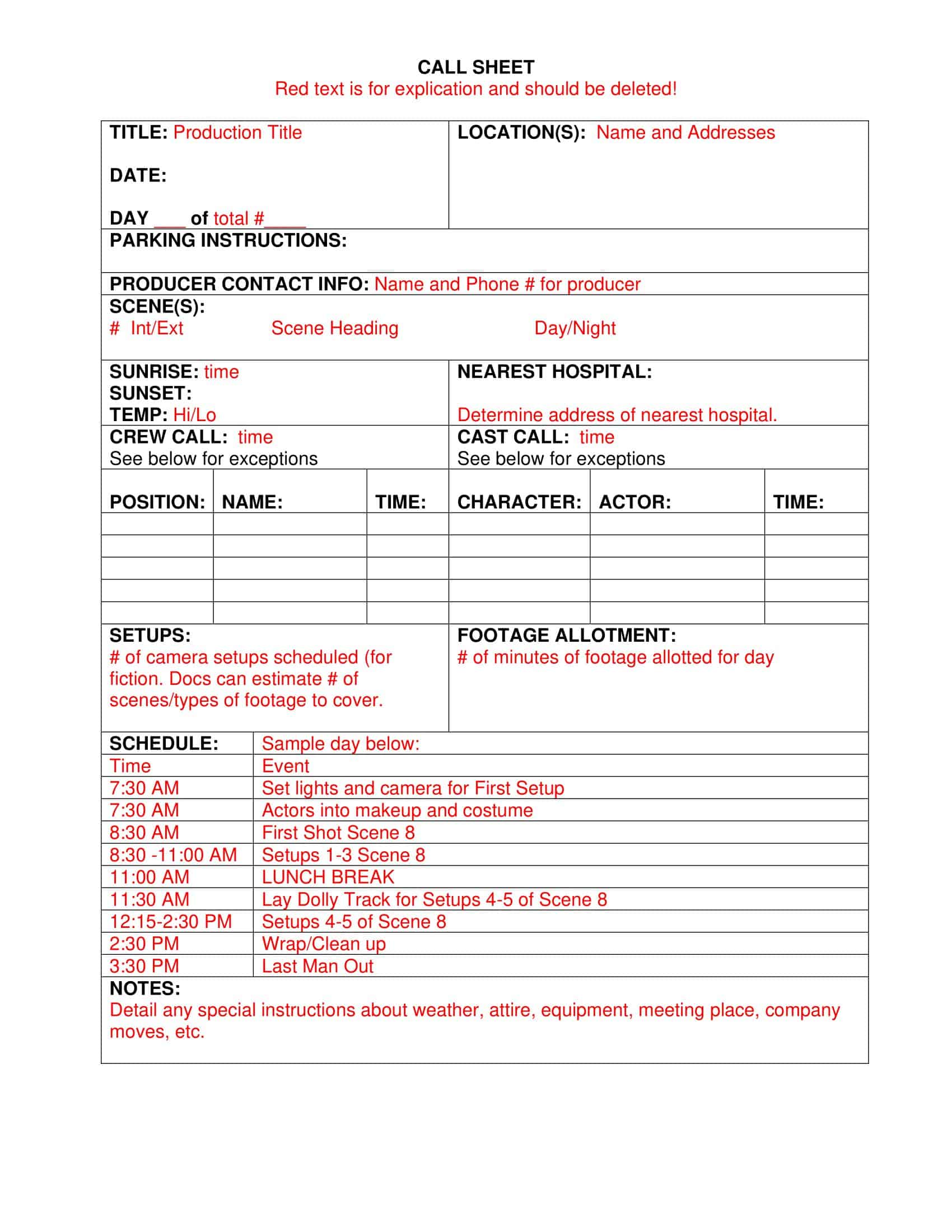

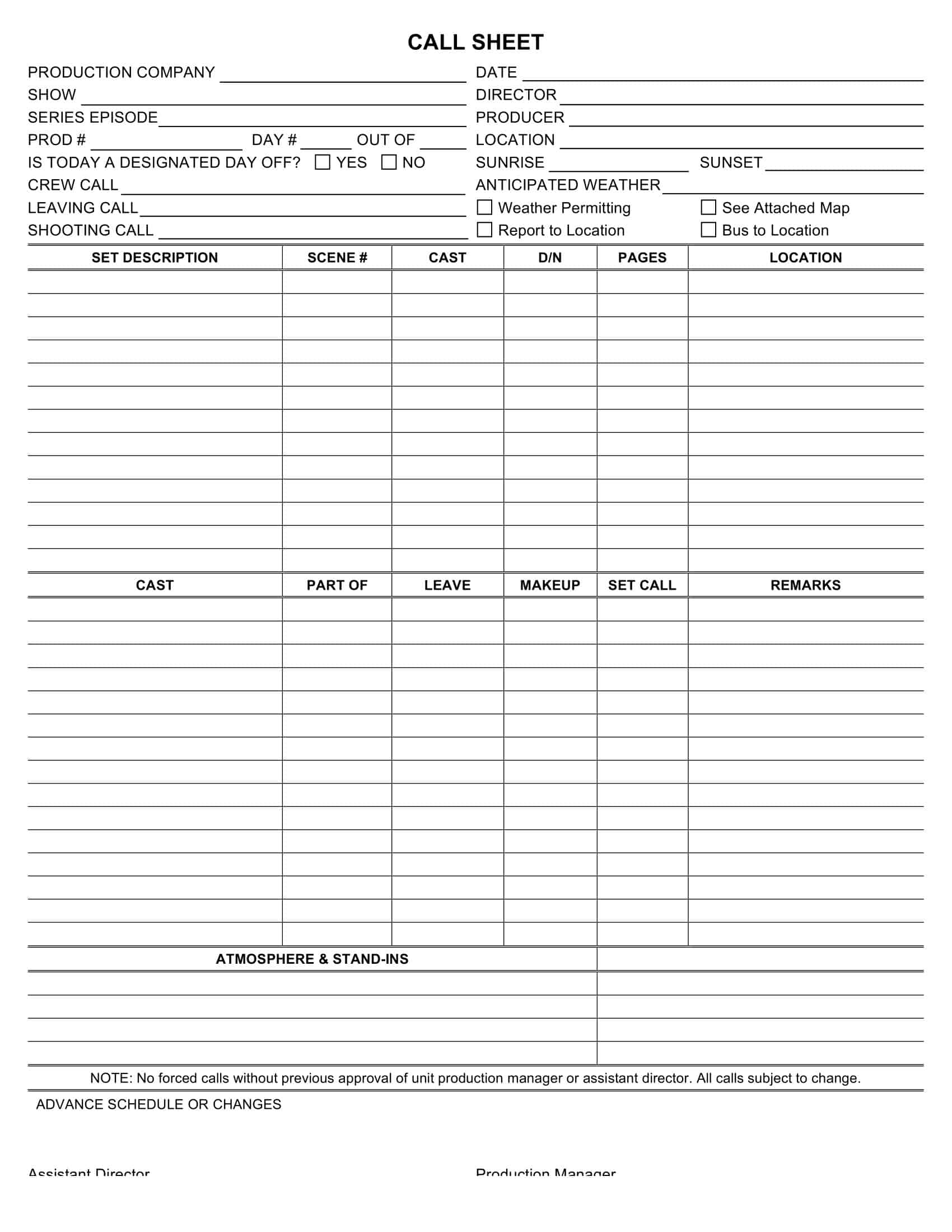





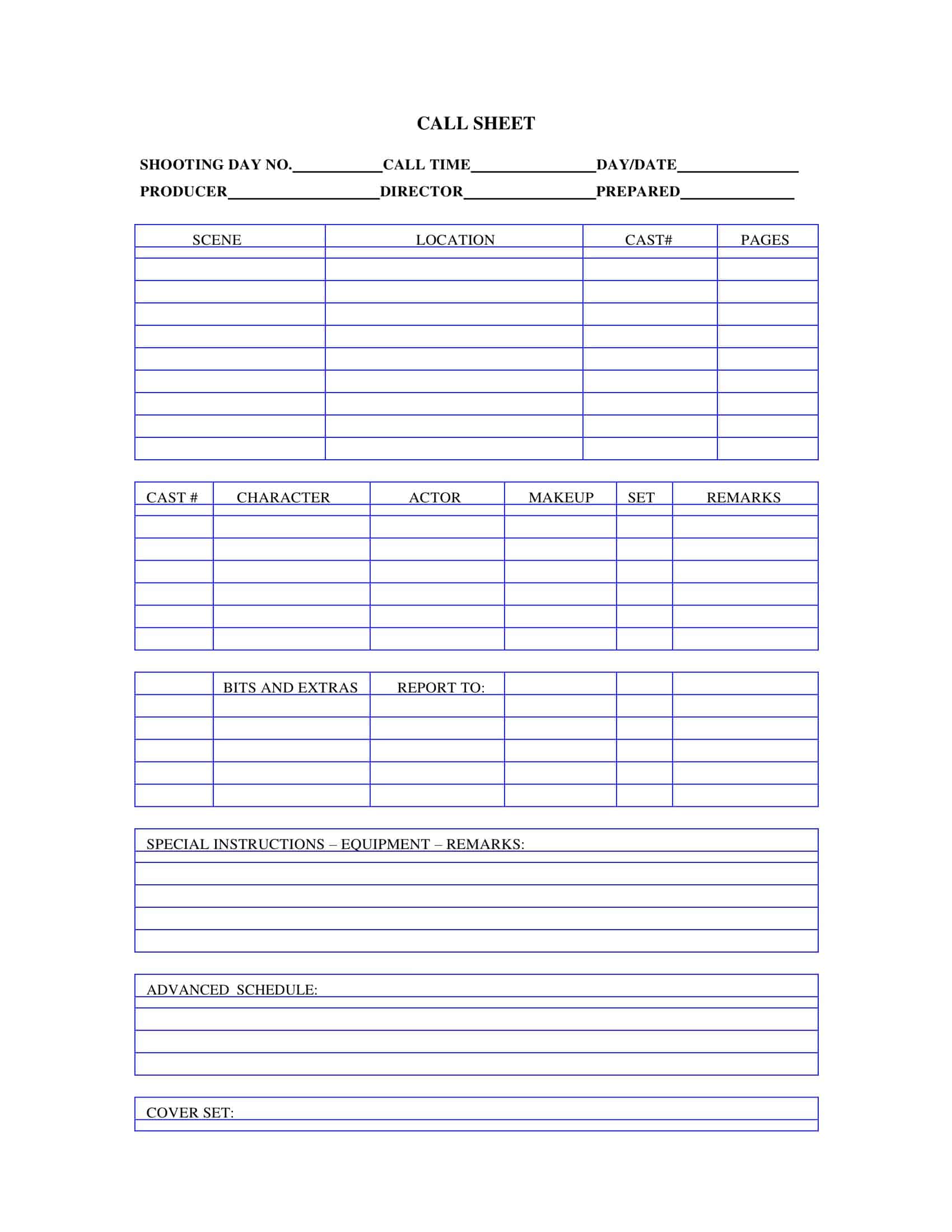
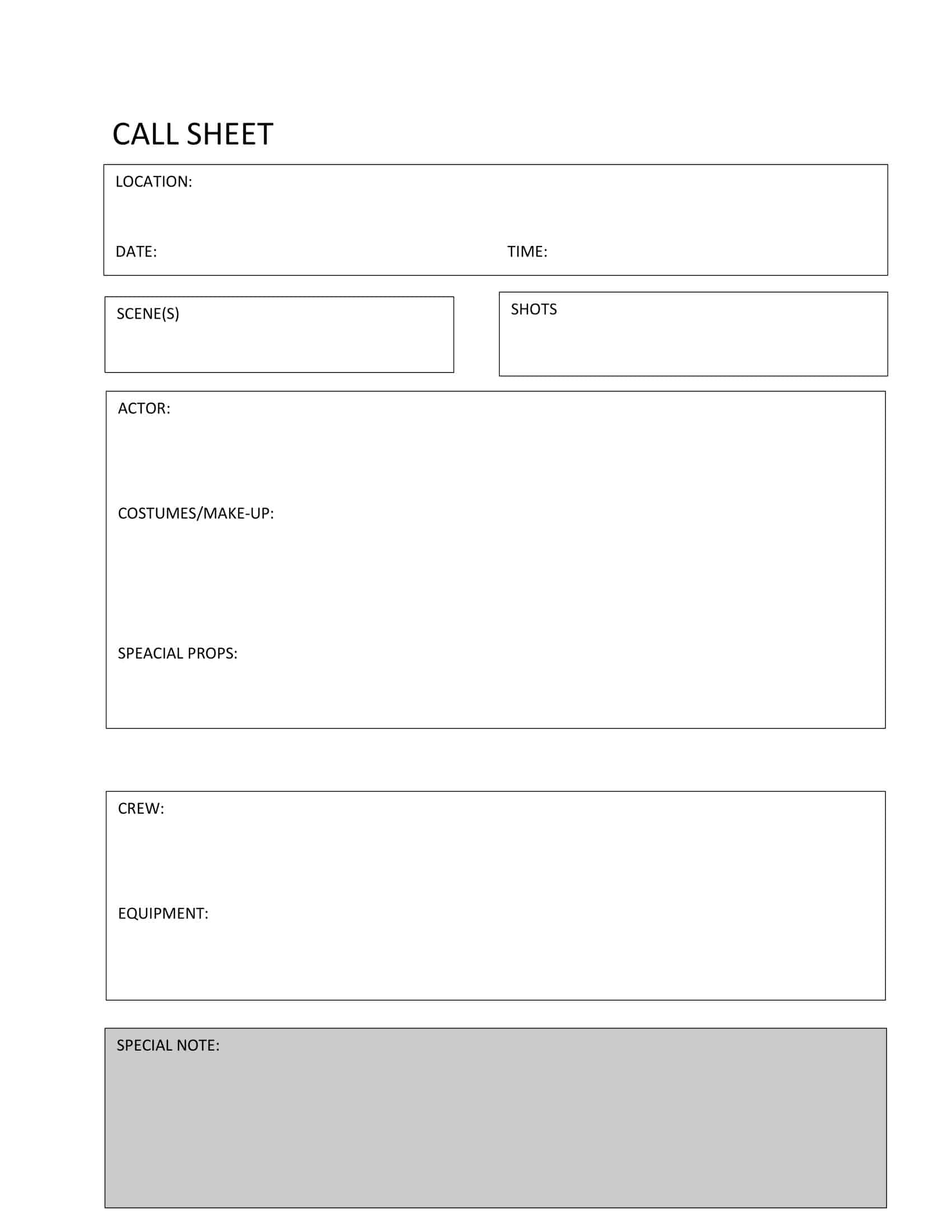
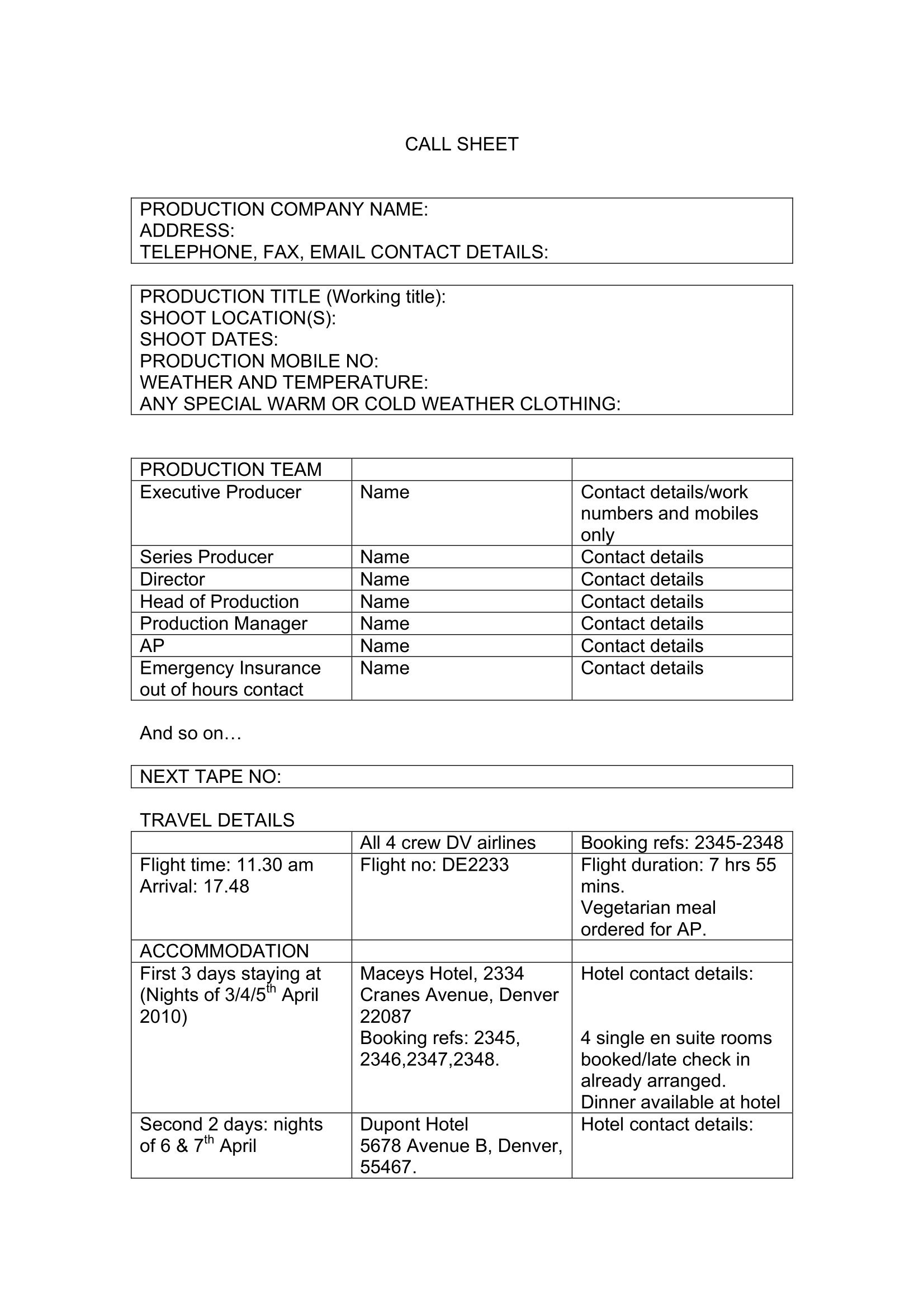

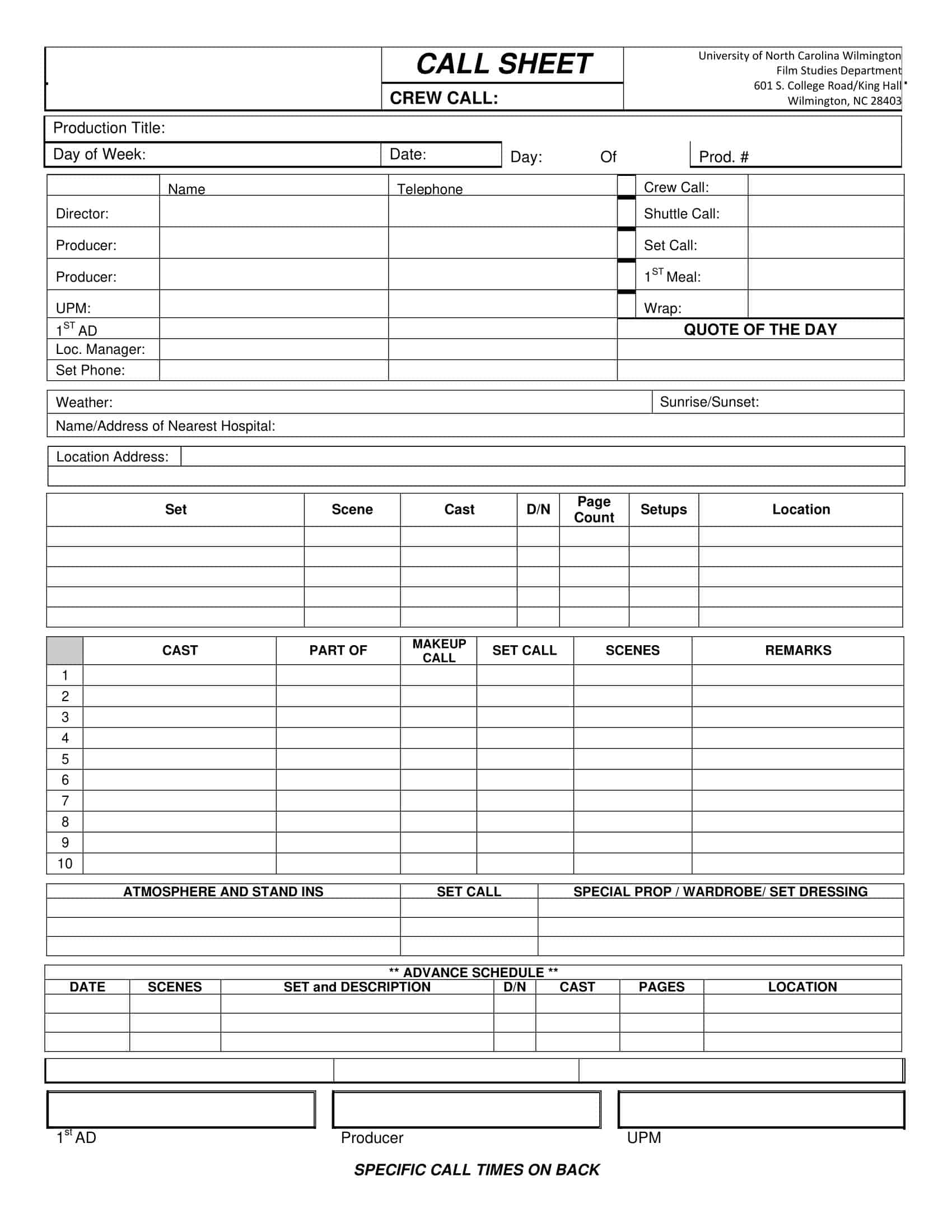




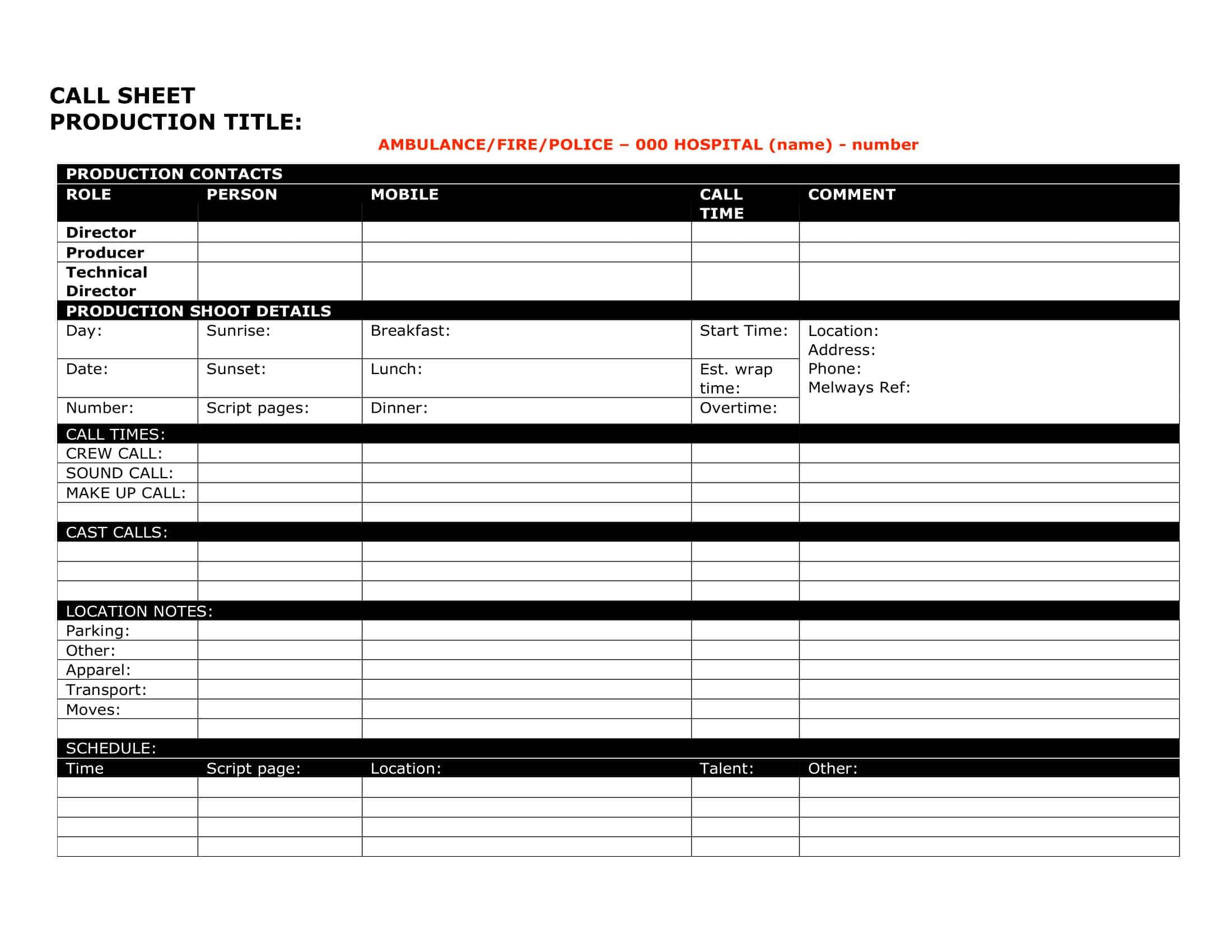
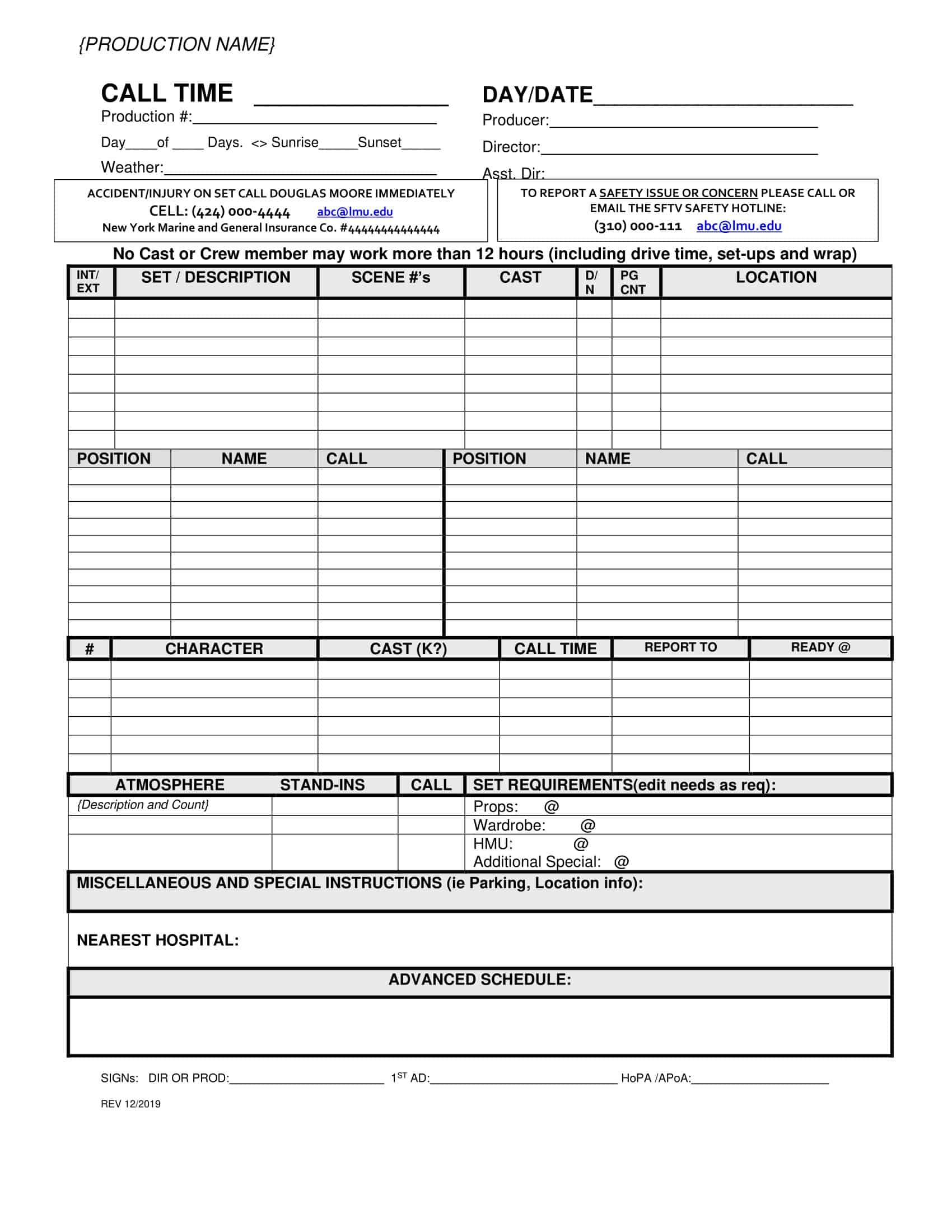













![Free Printable Roommate Agreement Templates [Word, PDF] 1 Roommate Agreement](https://www.typecalendar.com/wp-content/uploads/2023/06/Roommate-Agreement-150x150.jpg)
![Free Printable Credit Card Authorization Form Templates [PDF, Word, Excel] 2 Credit Card Authorization Form](https://www.typecalendar.com/wp-content/uploads/2023/06/Credit-Card-Authorization-Form-150x150.jpg)
![Free Printable Stock Ledger Templates [Excel,PDF, Word] 3 Stock Ledger](https://www.typecalendar.com/wp-content/uploads/2023/08/Stock-Ledger-150x150.jpg)
